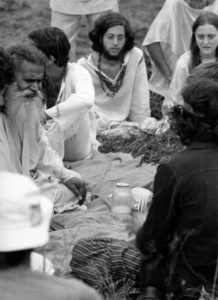WOODSTOCK — 50 years LATER

Photo courtesy of Richard Harris
By Shari Goldstein Stern
Boomers are likely to remember the summer of 1969, when an estimated half a million 1960s music enthusiasts descended on 600-acre farm grounds in Bethel, New York to enjoy the music of some of their favorite artists. A few of those were Joan Baez, Chicago, Three Dog Night, Jefferson Airplane, The Grateful Dead and Jimi Hendrix.
If we want to be jealous of anyone in the ’hood who was really at the record-demolishing Woodstock Music and Art Festival in 1969, he’s in Casa View. Richard Harris, who joined the peace and lovefest at the ripe age of 17, has a lifetime of stories to tell.
The teenager had just graduated from the High School of Music and Art in New York. He studied yoga with famous ’60s guru, Swami Satchidananda, who had the Integral Yoga Institute in New York. Swami had been invited to open the Woodstock Festival with a blessing of peace to the multitudes of people who had assembled.
According to Harris: “Because of the blocked roads leading to the festival, the Swami and some of the performers were not able to get to the site. It was getting later and later so Richie Havens, who was slated to go on fifth, was asked by the festival promoters to go up on stage and start playing.”
He added: “After playing everything he knew, he started improvising with his now-famous song, ‘Freedom,’ and when he was finished, the Swami had arrived by helicopter. Then Harris, along with about 25 of his fellow yogis and the Swami went on stage and became a part of history.”
Harris had the unique opportunity to view the remarkable crowd from the stage and remembers that it kept growing. He chatted with Havens while miles of traffic and pedestrians headed toward the grounds, where they had at one point torn down the fence. He reminisced: “It was like two different events. There was the concert and there was Woodstock Nation.” Friends, families and kids formed “tribes” that set up camp on the grounds near each other. Harris added with passion, “I was able to soak in the entire experience, and not just the music.
“That’s what made it special. It was living together with people you just met and forming bonds.” According to the baby boomer, “It was so peaceful to live, eat and dance together. The entire experience was an expression of — yes — peace and love. Expressing yourself in an honest way. There was no violence.”
Harris chronicled his experience. “[Woodstock] was a cultural touchstone,” he wrote. “Half a million young people were there, they lived in peace for three days without any visible form of security. They cooperated to share food and shelter.”
The baby boomer got emotional when he said: “Woodstock was the epitome of the ’60s, and expressed true values. It was about acceptance and diversity, freedom to express yourself and be yourself in an honest way with music as an integral part.”
He added: “It was about coming together. It was a tribal event on a mass scale of like-minded people.”
He reminisced, “When I was on stage, I knew that this was going to be one of the most momentous and historical events of the ’60s. I will never forget it.”
